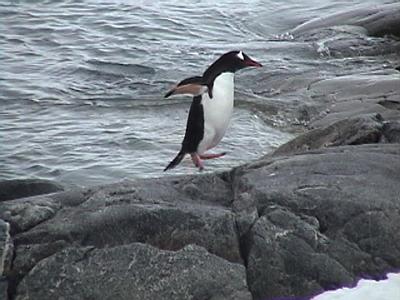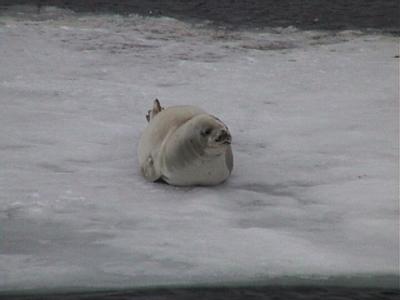2 December, 2000
Greetings,
It's Saturday night at Palmer Station. We had house mouse today. I was on
mash and grind. That is trash duty. My first job was to grind glass. It is
a machine that looks like a wood chipper. You feed the glass in a shoot and
it grinds the glass to small pieces. The bottles that have a deposit are
separated out while others are dropped down the shoot. When it is full it
gets sent back to a landfill. After grinding glass we mashed the trash in a
large compactor and put it in a van. The garbage will then be placed on the
Gould and finally end up in a landfill. We were so efficient at our job we
went to the galley and helped peel garlic for the week.
Today I spent my day running chlorophyll samples, working with Sarah on the
ac9 by running more clean water calibrations and working on short videos to
place on the web. "Night of the Living Krill" is headed your way along with
some more on penguins and possibly seals. During the day we had more
visitors. A crab eater seal, an elephant seal and several penguins. The
elephant seal had to be escorted twice to the water for bad behavior. He
kept coming onto the pier where we tie up our boats. For safety reasons we
asked him kindly to find a new place to beach himself for a while. He
finally got the message and went a short distance away but very close to
the lab.
Tomorrow I hope to take a zodiac out to recover some phytoplankton from an
iceberg. Once I have the phytoplankon I will use the station microscope to
determine what kinds of plankton are growing and to see if they're
different from the ones in the water. They have a microscope connected to
the microscope so I will be sending you a picture as well.
The answers to the following questions.
1. Why do you think water gets warmer after the first twenty-five meters?
In every other ocean the deeper you descend in the water the colder it
gets, but the southern ocean is different. The southern ocean is the ocean
that circles Antarctica. As you descend you encounter a large water mass
that has a different density and salinity than that of the water above it.
The way I understand this change in water temperature it is like a
temperature inversion where the warmer air is trapped below the colder air.
2. Why is the water less salty at the surface as compared to water at depth?
The water at the surface is less salty because of melting icebergs and
glaciers that add a considerable amount of fresh water to the surface. The
mixing of the water takes place slowly.
3. How far down does the visible light from the sun penetrate the ocean
surface?
The light from the sun penetrates the ocean to different depths depending
on what is in the water to absorb the light. One of those components is
the phytoplankton. When we were out in the zodiac on Friday testing the
irradiance using the PRR , the light diminished to almost zero at 32
meters. At the height of the plankton bloom about a month ago that was
about 12 meters.
4. How deep do phytoplankton species grow?
Phytoplankton likes the sun as most plants do. So most of the phytoplankton
will be found in the water where the visible light penetrates.
Phytoplankton have been found at greater depths, but the majority of it is
located in the area of the ocean where visible like can penetrate.
C-Ya tomorrow,
-- Bill
PS. Be sure to look for new movies coming to this web site.

The flying penguin?? No, I'm sorry! He was just leaping.

A Crabeater seal floating by on a piece of ice.

The Elephant seal finally found a place to get some sleep.
Contact the TEA in the field at
.
If you cannot connect through your browser, copy the
TEA's e-mail address in the "To:" line of
your favorite e-mail package.
|
